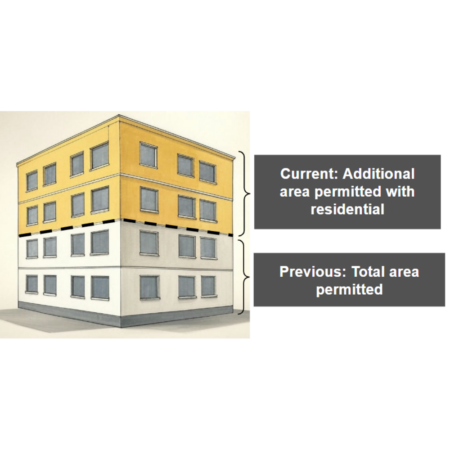The City of Asheville is updating codes in its Unified Development Ordinance (UDO) to better align with current needs and address challenges such as housing supply and attainability. A change to the code means the rules for guiding development will change in some way. Changes to the UDO could:
-
Address new development trends
-
Accommodate changes in resident preferences
-
Clarify existing code language
-
Promote affordable housing opportunities
-
Strengthen housing stability
-
Align with goals outlined in the Living Asheville Comprehensive Plan
Recent changes to the UDO include:
- Project Level Thresholds:
- This amendment raises the review threshold for some residential projects so that those with affordable housing can more easily get permits without having to be reviewed and approved by the Asheville City Council, which is a risky and costly endeavor. Projects within the following areas of the city are impacted by this ordinance. The example below demonstrates the intent of this change where previously projects of 50 or more units were required to have City Council review regardless of their actual impact whereas today the playing field has been leveled so that commercial and residential projects are reviewed more equitably.
Changes to Project Level Thresholds (Examples) |
||||
|---|---|---|---|---|
| Previous Threshold | Units |
Square Feet (SF) per Unit |
Gross Floor Area (GFA) | Council Review? |
|
Residential |
49 | 2500 SF | 122,500 SF | No |
|
Residential (market rate or affordable) |
50 | 600 SF | 3600 SF | Yes |
|
Commercial |
n/a | n/a | 99,000 SF | No |
|
Current Threshold |
Units | SF/Unit | GFA | Council Review? |
|
Residential (market rate) |
50 | 600 SF | 30,600 SF | Yes |
|
Residential (5% affordable) |
100 | 999 SF | 99,900 SF | No |
|
Residential (5% affordable) |
150 | 666 SF | 99,900 SF | No |
|
Commercial |
n/a | n/a | 99,900 SF | No |
- Parking Standards:
- This amendment removes all minimum off-street parking requirements for residential and other types of developments in certain zoning districts, primarily along transit-supportive corridors, giving developers more flexibility in how they design their projects, which could lead to lower housing costs. The amendment raises the minimum bicycle parking from 5% to 10% and also no longer permits projects to exceed the maximum vehicular parking standards.
- Commercial Zoning District Updates:
- This amendment updates certain commercial zoning districts to remove regulatory barriers to encourage the development of housing along commercial corridors, which could lead to more housing being built in areas that are currently underutilized. The key change is that projects that include housing within certain zoning districts are now allowed to increase the size of buildings, as shown below.

- Cottage Developments:
- This amendment changes the development regulations related to cottage developments- which are small, clustered communities of single-family homes- for certain areas of the city. The new changes reduce the minimum number of cottages from five to two, eliminate the 200-foot separation requirement between cottage developments, and eliminate the clause that orients cottages toward the primary street. Map of areas where updated ordinance applies.
- Flag Lots:
- This amendment updates regulations for flag lots, which are lots that have a long, narrow driveway leading to a building at the rear of the lot. The changes, which only apply to certain areas of the city, reduce the minimum width of the flag lot at the street from 20 feet to 16 feet, and allow the width to be reduced to 10 feet for flag lots that share the driveway with the parent parcel. The changes also limit the size of homes situated on a flag lot to 1,400 square feet (no more than 1,000 square feet on the ground floor), and allow more flag lots to be created in a subdivision (up from 10% to 25%). Map of areas where updated ordinance applies.
Engagement Hub
The engagement hub helps you stay informed and submit your questions and comments about the upcoming proposed text changes.
Engagement Hub for Proposed UDO Text Changes
You will find information on proposed text changes that are currently under public review. This is where you can ask questions about these text changes or leave comments for staff.
There are other ways for you to get more information or provide your feedback on a proposed text change. You can email the Planning and Zoning Commission or you can attend the Planning and Zoning Commission meeting during which the text change of interest will be discussed.
See the Council meeting dates and times or the Planning and Zoning Commission meeting dates and times and view the agendas and minutes for those meetings.
Text changes currently under review
This table contains UDO text changes that are currently under consideration. Click on the case number to learn more.
Text Changes Currently Under Review |
|||||
|---|---|---|---|---|---|
| Case Number | Case Name | Description | Status | Next Key Date | Contact |
| TBD | TBD | TBD | TBD | TBD | |
Text changes approved
This table provides the details and documentation for changes to the UDO that have already been adopted by the Asheville City Council and that are now effective City regulations.
Recently Adopted Changes |
||||
| Text Change Number | Ordinance Number | Title | Summary of Changes | Effective |
| 24-02604PZ | 5127 | Amendment to the Site Plan Review Thresholds for Development | Increases the size of a private development project that can be reviewed and approved administratively rather than by City Council vote along transportation corridors and mixed-use districts. | March 11, 2025 |
| 24-02605PZ |
5128 | Amendment to Residential Parking Requirements | Removes the requirement that new residential land development provide a minimum number of parking spaces along transportation corridors and within mixed-use districts. | March 11, 2025 |
| 24-06716PZ | 5129 | Amendment to Commercial Zoning District Standards | Updates the UDO’s definitions, table of uses, uses by right subject to special requirements, and certain commercial zoning districts to remove regulatory barriers and encourage the development of housing along transit-supportive corridors. | March 11, 2025 |
|
Flag Lots |
5126 | Update to Flag Lot standards within certain areas of the city |
Adopted changes are only applicable to areas outside of the parcels designated in Appendix 7-F. Key updates include a reduction to the minimum flag pole width, limitation on home size, and some setback reductions. |
March 11, 2025 |
|
Cottage Developments |
5125 | Update to Cottage Development standards within certain areas of the city |
Adopted changes are only applicable to areas outside of the parcels designated in Appendix 7-F. Key updates include a reduction in the minimum number of cottages and removal of separation requirements. |
March 11, 2025 |
Background
Asheville’s Unified Development Ordinance (UDO) is receiving an update.
The UDO, which was first adopted in 1997, doesn’t fully reflect the city’s current needs. Asheville has grown and changed a lot since then, and the UDO needs to be updated to help address the economic challenges caused by lack of housing supply.
One big issue is displacement. When cities grow, new development can sometimes push long-time residents out of their neighborhoods. This is a problem in many cities, and Asheville is no exception.
The City has recently completed two important projects to help us address housing affordability and displacement of longtime residents:
- The Missing Middle Housing Study looks at why it’s hard to build a variety of housing types in Asheville, and makes recommendations for how to increase housing supply while protecting neighborhoods that are vulnerable to gentrification.
- The Affordable Housing Plan outlines strategies to make housing more affordable, especially for residents who are most vulnerable to displacement.
Along with guidance from the Living Asheville Comprehensive Plan, City staff is working with residents, neighborhoods, boards and commissions and elected officials to make positive changes to the UDO. The goal is to promote housing development in our growing city that is good for everyone, especially people who have lived in Asheville for a long time.
Supporting Documents
Living Asheville (Comprehensive Plan)
Current Unified Development Ordinance (UDO)
Contact Information
Chris Collins, AICP
Planning & Urban Design Department, Assistant Director
828-273-0034
